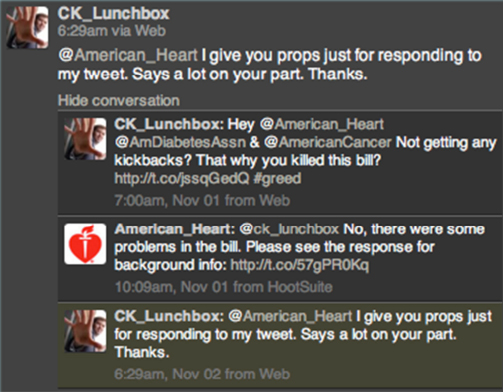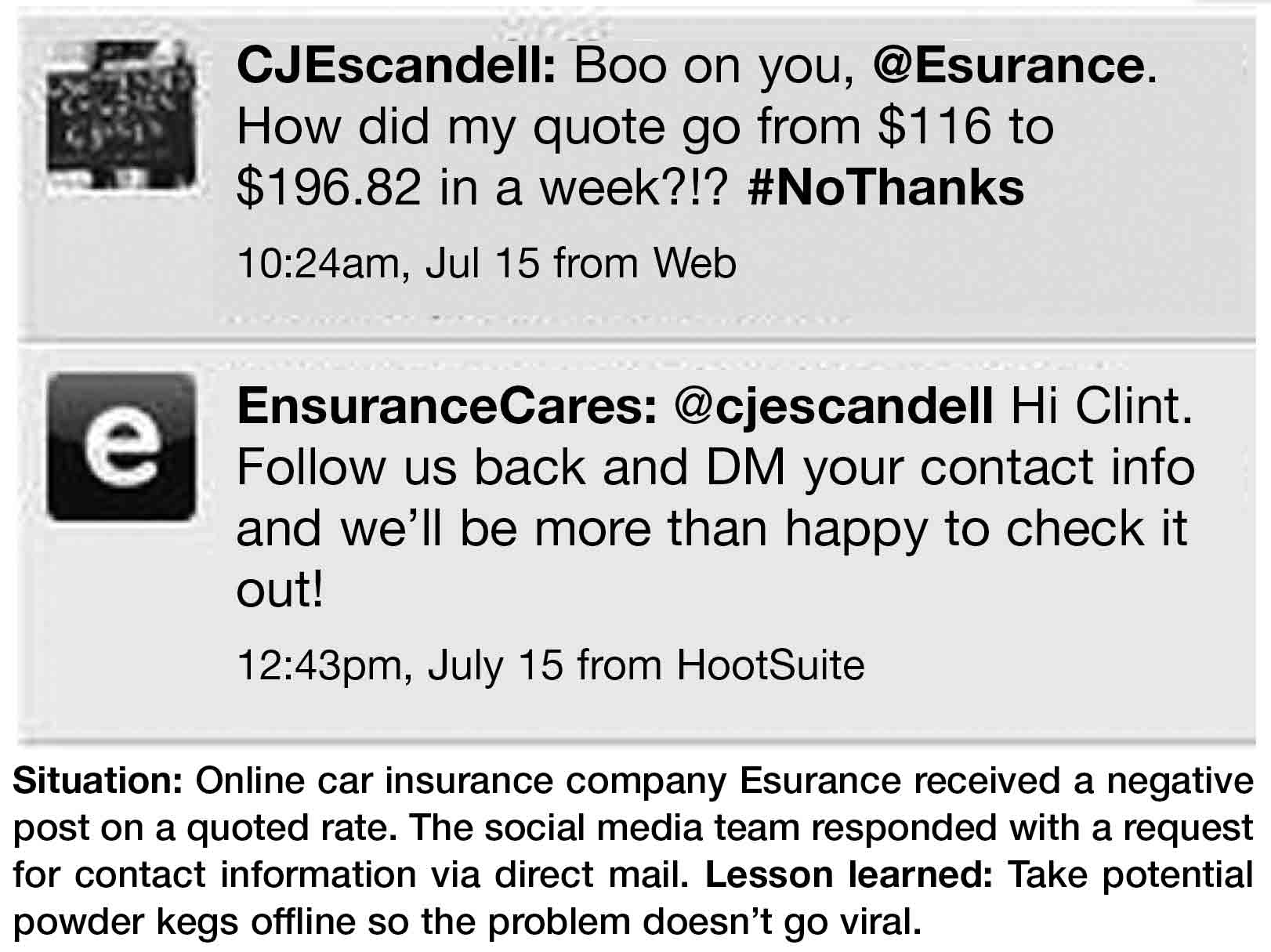For the most part, many organizations’ Twitter accounts smoothly hum along, filling up with innocent comments and links to content from loyal followers. In other words, all is right with the social media world.
But consider that there are now more than 400 million posts on Twitter per day (according to Twitter CEO Dick Costolo, as of June 2012). That means disaster can strike at any time. When a disgruntled customer decides to tell the world that your product or customer service is lacking, it’s crisis time, and how you respond to those tweets can make or break a brand’s reputation, at least in the short term.
So just how should these types of tweets be handled when they come in? Who determines whether it’s proper to respond, and how to respond? PR News spoke to the social media leaders of three organizations to find out.
 |
| Situation: A news comedy show aired a segment that said the American Heart Association fought a bill that would have rewarded healthy behavior. In fact, the bill might have opened the door for discrimination of people with preexisting conditions or who were predisposed to the conditions. After the segment aired, there was backlash via Twitter and Facebook, including the above Twitter string (Twitter handle intentionally blocked out). Lesson learned: Staying quiet will not make a crisis go away. |
CRISIS, OR NOT?
When a controversial post hits the American Heart Association, or when several people complain about an issue, Krisleigh Hoermann, AHA’s community manager, makes the call of whether to summon the AHA crisis team, which includes communicators and subject matter experts across the organization. The team then discusses the post and decides on a course of action, which could include:
• No response at all;
• A response but, if it’s a battle that can’t be won, only once to acknowledge the post; or
• A response and then a news statement—if the issue is serious enough.
Hoermann is the gatekeeper for such decisions, giving advice to some 60 Twitter account holders from national headquarters in Dallas and local AHA branches across the country.
QUICKNESS THE KEY
The process is different at American Airlines, where customer service issues pop up on Twitter on a regular basis. The mantra at AA, says Annette Hernandez, social media specialist at the airline, is responsiveness. “We must be extremely responsive and time-sensitive on Twitter,” she says.
If a post is a general complaint, the AA team gauges the tone of the customer and tweets an apology back. If it’s a specific problem—a flight delay or cancellation, for example—they’ll ask the customer to send a direct mail via Twitter with details and take the issue offline. “We don’t want these problems out there in the public,” says Jonathan Bird, creative manager, social media, at American Airlines.
In terms of process, Hernandez and Bird place a lot of trust in their customer service team, which they empower to make quick decisions. While not revealing how many people are on that team, Bird did say that many of the people who handle social media at AA come from the reservations department, and thus are fully versed in customer service.
The same structure and philosophy is mirrored at online car insurance company Esurance. There’s a team of six service agents who monitor Twitter for customer-related issues, and they have the authority to help a person right away, says Shannon Greevy, social media communications strategist, Esurance. “We don’t have a complicated system,” she says. “We want to be able to help people immediately.” (See the tweets for an example.)
 |
THE TURNAROUND
For Greevy, the challenge of effective Twitter responses is to turn a negative into positive. The trick is to find out what the customer is really upset about, and then work out a solution that will surprise them. “Many people who get upset think they’ll never have a good outcome,” says Greevy. AA’s Hernandez agrees with that strategy. “We consider every social touchpoint an opportunity to create our staunchest allies,” she says. Here are some other tips for effective response to Twitter posts:
• Be knowledgeable. Whoever is responding needs to be well-versed with company policies and the customer’s specific problem.
• Don’t be a robot: On social media—especially when handling complaints—avoid sounding too corporate, says Hoermann. Social media is a natural, conversational platform.
• Interact with your followers (even when they don’t have a beef): This allows you to know your customers better—what amenities and services they value most—which can only help during a social media crisis, says Bird.
• Have fun. This is AA’s No. 1 rule. “If you’re not having fun then the customers will sense it,” says Hernandez.
But not all is gloom and doom on a brand’s Twitter page. Followers do say good things about brands. A simple, quick “thank you” works well in response to positive posts at AHA. Those tweets are marked “Favorite” and can be accessed as a list for all to see, says Hoermann.
As your organization’s social media leader, those are the kind of posts you’ll want to strive for. PRN
[Learn more from Bird, Hoermann and Greevy at the PR News Big 3 Conference—Twitter, Facebook and Pinterest—set for August 9 in San Francisco (prnewsonline.com/theBigthreeconference/).]
CONTACT:
Annette Hernandez, [email protected]; Jonathan Bird, [email protected]; Krisleigh Hoermann, [email protected]; Shannon Greevy, [email protected].
Follow Scott Van Camp: @svancamp01
